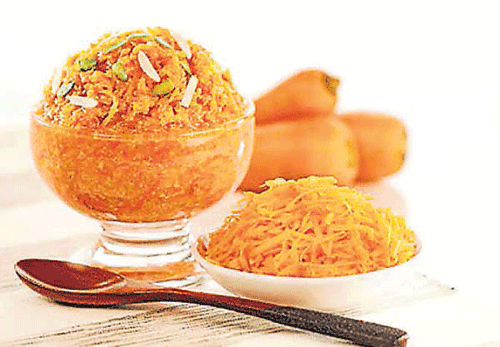
If there is one dessert that can be made of anything - from eggs to nuts to vegetables, it is halwa, writes KDL Khan.
Halwa, is believed to have been brought to India by the Arabs. The word ‘halwa’ is incidentally derived from the Arabic word ‘hulw’ meaning sweet. This original middle eastern dessert was made from date paste and milk. Even today, the Arabs serve Omani Halwa to special guests. Made from starch, eggs, sugar, nuts, and ghee, it takes two hours to cook and remains unspoilt for four months even without refrigeration or adding preservatives.
But, who can deny that we Indians have transformed the halwa beyond recognition. In India, there is a halwa to suit any occasion. There is the evergreen Suji Halwa — or Atta Halwa— served as consecrated karha parsad as the Gurudwara’s quintessential blessed food. With a tinge of yellow, it becomes Kesari Bhaat in the South. Replace semolina or flour with ground lentils or grams and you can enjoy moong dal or Besan Halwa. For special occasions, one may prepare Badam Halwa. Small towns in Uttar Pradesh with a large Muslim population continue to make delightful Anda Halwa; even those who routinely demolish large cakes made of eggs find this dish exotic. The Gajar Halwa is a must have during winter when the carrots are red and juicy.
The specialised Halwai trade is almost exclusively a Hindu preserve. The typical north Indian halwa can be made from different types of flour, pulses, vegetables, fruit, dry fruits, and even eggs. The basic recipe lists wheat flour (atta), ghee, and jaggery (gur) dissolved in milk among other optional ingredients such as cashewnuts, raisins, and a pinch of nutmeg or cardamom powder to enhance the flavour. Over the years atta was substituted with semolina (rawa) or refined flour (maida) and jaggery with sugar. Bombay Halwa is made from rawa. Sindhis thrive on halwa made from lapsi or dalia (broken wheat).
In Nepal, they make a sweet halwa from carrots and barley and a savoury one with, ghee, water, and salt. Sohan Halwa, once synonymous with Delhi, came in the form of a large round toffee, akin to lockjaws and multi-hued chewy Karachi Halwa. This sweet was quite a rage in the early 1950s. Jauzi Halawa Sohan, prepared with samnak (wheat germ) in Lucknow, was an Awadh speciality. Legend has it that unless the dewdrops rained on a moonlit night on the samnak used, the halwa didn’t acquire the right taste. On special occasions, a velvety smooth halwa, rich with almonds, golden with the tinge of saffron, smelling sweetly of cardamoms, strewn with rose petals and cashews is served. It is a Badam Halwa fit for an emperor! Another Muslim delicacy, the Kharak Halwas, owes its culinary origins to the Bohra community of Gujarat. It has the softness of milk and khoya, the sweetness of sugar, and the richness of de-seeded dates, walnuts, and cashews.
From the west we head east towards Bengal for the Cholar Dal Halwa. This is a typical Bengali delight made from gram dal. Dripping ghee, strewn with dry fruits, it has the whiff of whole garam masala and tej patta (bay leaf) which are removed just before serving. A simpler halwa is the Mohan Bhog made from semolina, milk, and sugar. It is served with luchis (puris) for breakfast. Down south, the Moong Dal Halwa is a delicacy. Made from a paste of moong dal soaked overnight, it is wholesome and filling. In Kerala, the Kozhikodan Haluwa, from Kozhikode, is famous for its exotic taste.
Significant Arab and Middle Eastern influence in Kerala contributed to the Karutha Haluwa (black haluwa), made from rice, is also very popular. Kashi Halwa, made from winter melon orash gourd, is a famous and traditional sweet in Karnataka, and mainly makes a regular appearance in traditional Brahmin weddings. Another prominent South Indian version of halwa is Aluwa from Tirunelveli of Tamil Nadu.
Believe it or not, you can make halwa out of anything. Even red chillies! Let us take the case of Pune’s Hari Mirch Halwa. One of the best innovations in the history of Indian food, this one can cross the cake off your favourite list of desserts! Imagine, the joy of being able to eat chillies without losing your sweat over it! A sweet blend of green chillies, flavoured milk powder and cream, this halwa is a speciality of Pune, making it one of the most popular items on the Bengali wedding menus. If you fancy red chillies, then you can have Laal Mirch Ka Halwa too!
Recently, of all the halwas in India, the Tirunelveli Halwa got geographical indication in India, when a Tamilnadu High Court ruled that only a 200 year old shop in Tirunelveli known as “Iruttukadai” has the exclusive right to sell the “ Iruttukadai Tirunelveli Halwa’- a famous sweet dish made of wheat and sugar. The shop opens only in the evenings and sells hundreds of kilograms of halwa every day.
“The Iruttukadai Halwa is prepared over three days. We extract the wheat milk on day one and let it ferment overnight, the halwa is prepared the next day and sold on day three,” reveals the halwa maker, referring to the secret behind the taste of this exotic dish.